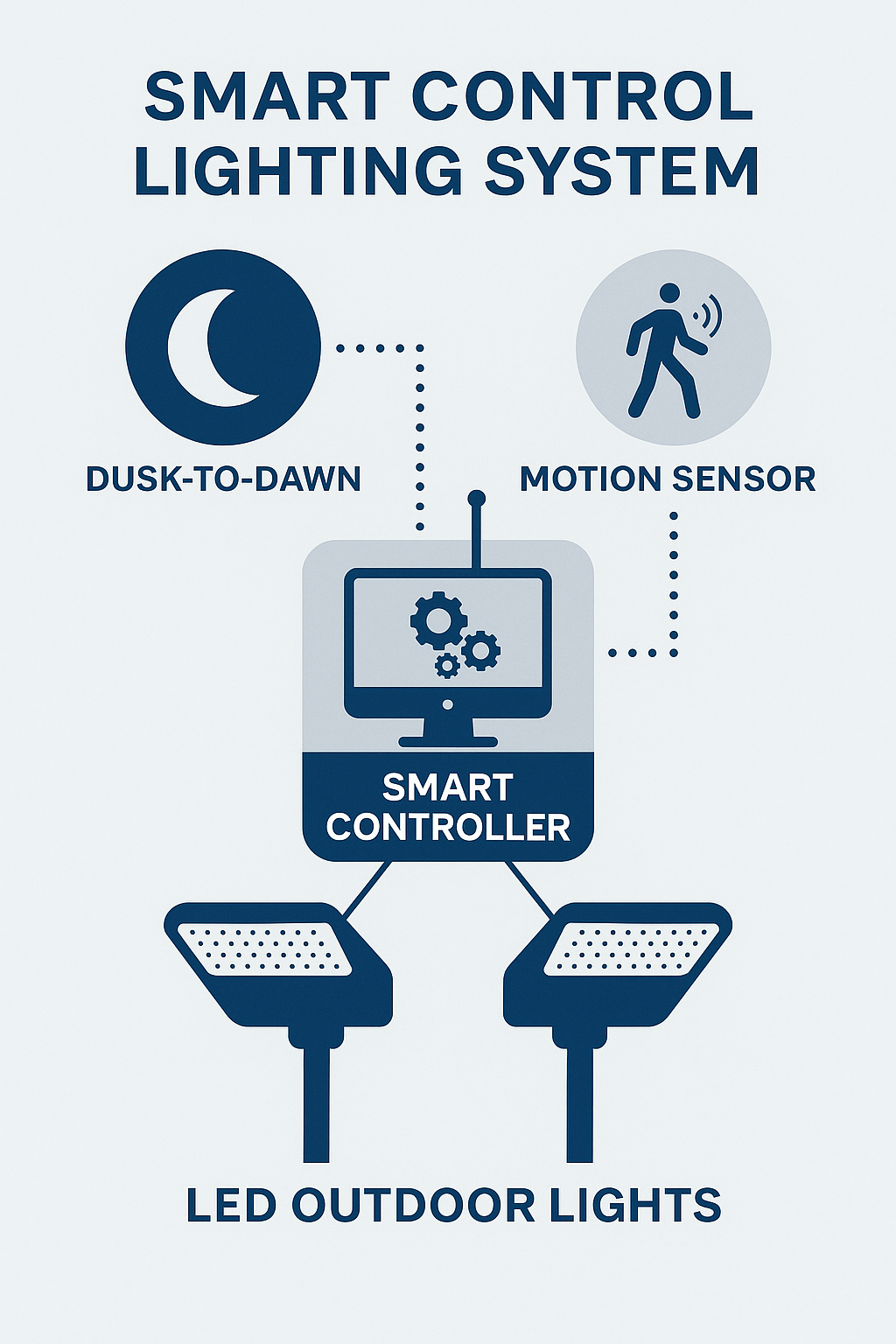Introduction
Outdoor lighting plays a pivotal role in determining the operational costs for businesses, municipalities, and industrial facilities.
From warehouse exteriors to parking lots and pathways, the choice of lighting solutions directly impacts monthly utility bills and long-term maintenance budgets.
Energy-efficient LED outdoor lighting provides a strategic opportunity to significantly lower these costs, reduce maintenance frequency, and support sustainability initiatives.
This article explores how upgrading to LED technology delivers measurable financial and operational advantages.
1. Why Outdoor Lighting Matters for Operating Costs
1.1 The Hidden Costs of Traditional Outdoor Lighting
Traditional outdoor lighting systems, such as incandescent, metal halide, or high-pressure sodium lamps, are highly inefficient.
They consume large amounts of electricity, generate excessive heat, require frequent replacement, and contribute heavily to a facility’s carbon footprint.
Every hour these outdated lights operate leads to wasted energy and inflated utility bills.
Moreover, frequent lamp failures drive up labor and equipment costs for maintenance teams.
1.2 The Shift Towards LED Technology
In recent years, the global shift towards LED lighting has accelerated.
According to the U.S. Department of Energy (DOE), widespread LED adoption could save 348 terawatt-hours of electricity annually by 2027 — equivalent to the output of 44 large power plants.
Businesses that adopt LEDs today gain a competitive advantage by immediately lowering their operational expenses while future-proofing their facilities.
2. Understanding the Energy Efficiency of LED Outdoor Lights
2.1 How LED Lights Work Differently
Unlike traditional lamps that waste energy by emitting heat, LEDs convert nearly all electricity directly into visible light.
This efficiency is achieved through advanced semiconductive materials that emit photons when an electric current passes through.
2.2 Comparative Energy Consumption
| Lighting Type | Average Lifespan | Energy Efficiency | Maintenance Needs |
|---|---|---|---|
| Incandescent | 1,000 hours | Very low | Very high |
| Metal Halide | 12,000–24,000 hours | Moderate | High |
| LED | 50,000–100,000 hours | Very high | Very low |
LEDs outperform traditional options across all critical metrics, making them the ideal choice for energy-conscious businesses.
3. Direct Financial Impact: How LEDs Reduce Costs
3.1 Lower Electricity Bills
By switching to LEDs, businesses typically achieve energy savings of 50–75% or more.
For example, a commercial parking lot retrofit project showed a 78% reduction in lighting energy consumption after replacing just 25 fixtures.
These substantial savings directly improve the bottom line, month after month.
3.2 Reduced Maintenance and Replacement Costs
LED fixtures last up to 25 times longer than traditional bulbs, drastically reducing maintenance schedules and associated labor costs.
Their solid-state construction resists shock, vibration, and temperature extremes, making them ideal for harsh outdoor environments.
3.3 Faster ROI (Return on Investment)
Depending on energy rates and project size, most LED retrofit projects achieve payback within 2 to 5 years.
Beyond the break-even point, every dollar saved contributes to pure profit.

4. Advanced Technologies Enhancing LED Outdoor Lighting
4.1 Smart Controls
Modern LED outdoor systems often integrate:
- Motion sensors (activating lights only when needed),
- Dusk-to-dawn photocells (automatically adapting to ambient light),
- Wireless smartphone control systems (allowing real-time adjustments).
These smart technologies further optimize energy use and enhance site security.

4.2 Next-Generation Lighting Innovations
- Multi-stage Filtration: Protects LED lenses from dirt buildup, maintaining performance over time.
- Automatic Variable Filtration (AVF): Dynamically adjusts brightness based on weather and light conditions.
- Nanotechnology Applications: Enhance light quality, fixture durability, and minimize energy loss.
- Acoustic Nanotube Technology: Futuristic systems that may harvest sound energy to power lights sustainably.
Choosing LED systems with these advanced features ensures businesses maximize both performance and efficiency.
5. Environmental and Corporate Sustainability Benefits
5.1 Reducing Carbon Footprint
LED lighting dramatically lowers greenhouse gas emissions, helping businesses meet regulatory requirements and voluntary ESG (Environmental, Social, Governance) goals.
By upgrading outdoor lighting, companies contribute to environmental conservation efforts while also improving energy security.
5.2 Strengthening Brand Image
Today’s consumers and corporate partners increasingly favor eco-conscious brands.
Demonstrating a commitment to sustainability through LED upgrades enhances reputation and market appeal.
6. Practical Guidance for Businesses Transitioning to LED Outdoor Lighting
6.1 Step-by-Step Transition Plan
- Conduct a professional lighting audit.
- Prioritize areas with high daily runtime (e.g., parking lots, building perimeters).
- Select certified LED products with high efficacy ratings and strong warranties.
- Incorporate smart controls where feasible.
- Plan gradual retrofits to manage budget and minimize operational disruption.
6.2 Key Factors When Selecting LED Outdoor Lights
- Wattage and Lumen Output: Ensure sufficient illumination without waste.
- Ingress Protection (IP66+): For reliable performance in rain, dust, and humidity.
- Surge Protection (10kV+): Safeguards against lightning and power fluctuations.
- Certification: Look for CE, DLC Premium, RoHS compliance.
7. Case Studies: Real-World Savings from LED Outdoor Lighting
7.1 Commercial Warehouse LED Retrofit
- Scope: 300 outdoor fixtures replaced.
- Results: 62% reduction in energy bills, payback in 2.8 years, improved loading dock safety.
7.2 Retail Center Outdoor Lighting Upgrade
- Scope: Parking lot and facade lighting retrofit.
- Results: 74% electricity savings, 5x brighter environment, improved customer satisfaction scores.
8. Conclusion
LED outdoor lighting is no longer a “nice-to-have” — it is a critical, strategic investment for businesses seeking to lower operating costs, enhance safety, and meet sustainability mandates.
Whether managing a retail center, a logistics hub, or a municipal facility, upgrading to energy-efficient LED solutions unlocks immediate and long-term benefits.
👉 Contact us today to schedule your FREE outdoor lighting energy audit and discover customized savings opportunities!
FAQ Section
Q1: How do LED lights reduce energy consumption?
LEDs efficiently convert electricity into visible light with minimal heat loss, meaning they use far less power compared to traditional incandescent or fluorescent bulbs.
Q2: What are the benefits of energy-efficient lights?
Energy-efficient lights deliver lower electricity bills, longer service life, reduced maintenance requirements, better lighting quality, and enhanced environmental sustainability.
Q3: Are outdoor LED lights expensive to run?
No. Outdoor LED lights are very economical to operate, typically consuming up to 75% less energy than older lighting technologies.
Q4: Is it cheaper to leave an LED light on or turn off?
It is always cheaper to turn off LED lights when not needed. LEDs are energy-efficient but still consume power while operating, so switching them off saves money.

